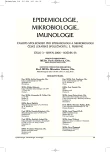Phage Types and Virulence Markers of Clinical Isolates of Salmonella Enteritidis
Authors:
Ľ. Majtánová; V. Majtán
Authors‘ workplace:
Slovenská zdravotnícka univerzita, Odd. mikrobiológie, Bratislava
Published in:
Epidemiol. Mikrobiol. Imunol. 55, 2006, č. 3, s. 87-91
Overview
A set of 487 clinical isolates of Salmonella Enteritidis were phage typed and analyzed for virulence markers, i.e. bacterial cell surface hydrophobicity, motility, biofilm formation and the presence of a 60 kb serovar-specific virulence plasmid.
The most frequent phage type was PT8 (48.3%), followed by PT13a (7.2%), PT15 (6.4%), and PT4 (4.5%). Thirty-one (6.4%) strains were non-typeable. As many as 128 (26.3%) strains showed hydrophobicity in the hydrocarbon xylene adherence assay, with the highest percentages of highly hydrophobic strains being found among the following phage types: PT9a (84.6%), PT25 (81.8%), PT15 (54.8%) and PT8 (23.4%). Motility ≥ 50 mm was observed in 294 (60.4%) strains and visible biofilm was formed in the test tube assay in different degrees by 448 (91.9%) strains. The capacity of in vitro biofilm formation is indicative of a high virulence potential of the study strains. The 60 kb serovar-specific virulence plasmid was present in 467 (95.9%) strains. Clear correlation between phage types and particular virulence markers was not revealed in the study set of strains. The obtained in vitro results are suggestive of flexibility of Salmonella Enteritidis in infecting the host.
Key words:
Salmonella Enteritidis – phage type – virulence – serovar-specific virulence plasmid.
Labels
Hygiene and epidemiology Medical virology Clinical microbiologyArticle was published in
Epidemiology, Microbiology, Immunology

2006 Issue 3
Most read in this issue
- Aeromonas spp. as the Causative Agent of Acute Diarrhoea in Children under 1 Year of Age
- Head Louse: Taxonomy, Incidence, Resistance, Delousing
- Seroprevalence of Antibodies Against Hepatitis A Virus and Hepatitis B Virus in Nonvaccinated Adult Population over 40 Years of Age
- Molecular Detection and Subtyping of Treponema pallidum subsp. pallidum in Clinical Specimens
